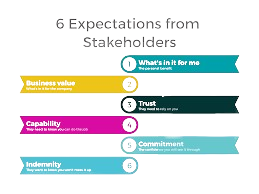Stakeholder engagement is fundamental for project success. Although it’s a complex process, there are some tactics you can follow to achieve the best results.
Engage, Listen To, And Work With Your Stakeholders
Stakeholder engagement is crucial for project success, ensuring everyone understands the project’s goals and contributes their best efforts. As a learning and development leader, mastering selecting, engaging, and communicating with stakeholders can reduce project risks and ensure project success.
7 Strategies For Successful Stakeholder Engagement
1. Select Your Stakeholders
To engage stakeholders in a project, create a list of all those affected, including internal and external parties. Prioritize them based on their value and voice in the project. Stakeholder value is the amount of revenue, resources, or capital captured by a specific stakeholder, while their voice is their influence on the organization. High-value stakeholders are responsible for capturing value and are trusted.
2. Understand Stakeholder Needs And Expectations

Understanding stakeholder needs and expectations is crucial for successful project management. By asking questions and listening to each stakeholder, you can gain insight into their perspectives and effectively manage polarities, thereby tailoring communication and engagement efforts.
3. Communicate Early And Often
Effective communication is crucial for stakeholder engagement. Utilize various channels like emails, newsletters, social media, and meetings to keep stakeholders informed about project progress. Encourage online meetings to share feedback and address concerns, while leveraging suggestions and recommendations.
4. Build Coalitions

Building coalitions with stakeholders is crucial for successful engagement. Establishing rapport and trust is essential, and showing value for input is crucial. High-impact coalitions connect organizations with industry, academia, NGOs, and government to solve problems. The COVID-19 Healthcare Coalition (C19HCC) was an effective example, involving 18 leaders from Amazon Web Services, Epic, Mayo Clinic, and Microsoft to address specific issues during the pandemic.
5. Seek Stakeholder Feedback
Coalitions with stakeholders are crucial for successful engagement, establishing trust and value for input. High-impact coalitions, like the COVID-19 Healthcare Coalition, connect organizations to address specific issues.
6. Keep Ahead Of The Change
Stay informed about project trends and research, share with stakeholders, adjust strategy as needed, anticipate challenges, and be proactive in addressing them to avoid surprises and keep stakeholders engaged.
7. Measure, Evaluate, And Recognize Engagement

Regularly measure and evaluate stakeholder engagement efforts to inform project progress and recognize their contributions. Utilize platforms to leverage tools and data analytics for better measurement and recognition. Building coalitions strengthens long-term relationships with stakeholders.
Conclusion
Stakeholder engagement is crucial for project success, involving both internal and external stakeholders. Effective communication, relationship building, feedback seeking, and proactive evaluation of stakeholder engagement enable organizations to leverage their insights and contribute to successful business outcomes.










